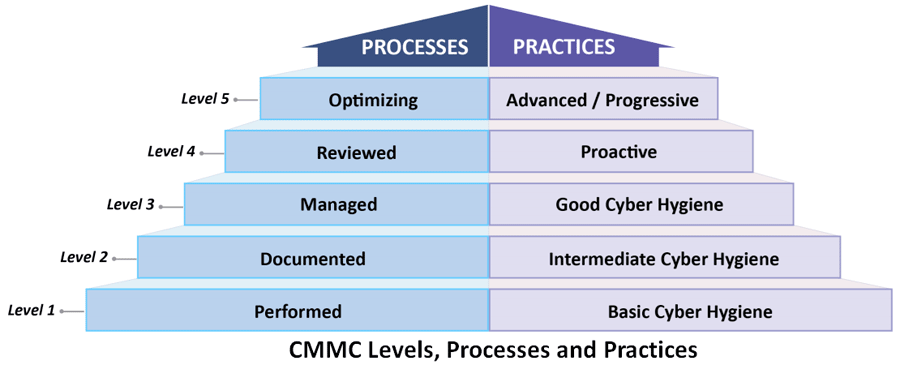The Cybersecurity Maturity Model Certification (CMMC) is a framework developed by the United States Department of Defense (DoD) to enhance cybersecurity practices and protections across the defense industrial base (DIB). It is designed to improve the security posture of organizations that work with the DoD by establishing a standardized set of cybersecurity requirements. CMMC is a tiered certification process, with each level representing a higher degree of cybersecurity maturity and capability.
Key benefits and aspects of CMMC
- Enhanced Security: CMMC provides a structured approach to cybersecurity that helps organizations strengthen their security practices, reducing the risk of data breaches, cyberattacks, and information theft.
- Protection of Sensitive Data: By implementing CMMC requirements, organizations can better protect sensitive government information and controlled unclassified information (CUI) that they handle as part of their contracts with the DoD.
- Standardization: CMMC establishes a standardized set of cybersecurity requirements and practices, ensuring that all organizations in the DIB adhere to a common baseline of security.
- Competitive Advantage: Certification at higher CMMC levels can provide a competitive advantage, as it demonstrates a commitment to cybersecurity and compliance with DoD requirements, potentially leading to more contract opportunities.
- Risk Mitigation: CMMC helps organizations identify and mitigate cybersecurity risks, reducing the likelihood of costly security incidents and associated reputational damage.
- Tiered Certification: CMMC consists of five levels, each representing a different degree of cybersecurity maturity and capability. Organizations must achieve the appropriate level of certification based on their role in the DIB and the sensitivity of the information they handle.
- Audited Certification: To attain CMMC certification, organizations are required to undergo third-party audits by certified assessors. These audits assess the organization's compliance with the specified cybersecurity controls and practices.
- Control Families: CMMC is organized into control families, each containing a set of cybersecurity controls and practices. These controls are based on established frameworks like NIST SP 800-171 and go beyond them to encompass more advanced security measures.
- Continuous Improvement: CMMC encourages organizations to continuously improve their cybersecurity practices over time. Higher levels of certification require more advanced security measures and practices.
- Contractual Requirement: The DoD has incorporated CMMC requirements into its contracts. To participate in DoD contracts, organizations in the DIB must meet the specified CMMC certification level.
- Protecting Controlled Unclassified Information (CUI): One of the primary objectives of CMMC is to protect Controlled Unclassified Information (CUI). CUI includes sensitive information that, if compromised, could harm national security.
- Adaptability: CMMC is designed to be adaptable and scalable, allowing organizations to tailor their cybersecurity practices to their specific needs while still adhering to the overall framework.
- Education and Training: CMMC emphasizes the importance of education and training to ensure that personnel are aware of cybersecurity risks and best practices.
- Enforcement: Failure to meet CMMC requirements can result in contract disqualification or penalties, making compliance a critical business consideration for organizations in the DIB.
CMMC represents a significant step forward in strengthening the cybersecurity defenses of organizations in the defense industrial base and, by extension, the protection of sensitive government information. It sets a higher bar for cybersecurity practices and requires organizations to continually evolve and mature their security capabilities.
Take Free CMMC Self-Assessment
https://www.securitycompliance.io/register
To learn more about Cybersecurity Maturity Model Certification (CMMC), visit the following link:
https://www.securitycompliance.io